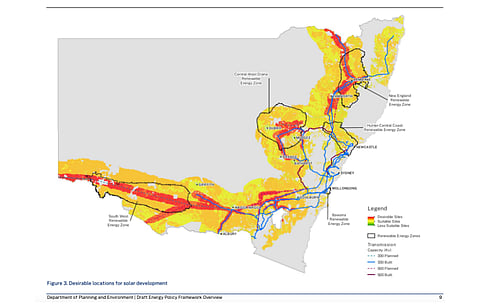

The share of desirable and suitable sites for large-scale solar PV power plants heavily overshadows wind energy in the draft energy guidelines issued by New South Wales (NSW), Australia that are aimed at accelerating their development.
Released by NSW's Department of Planning and Environment, the guidelines will promote faster decisions and provide certainty to investors and industry, while improving transparency for communities.
These are aligned with the recommendations made by the Electricity Supply and Reliability Check Up and NSW Agriculture Commissioner's report on renewable energy generation and agriculture, it said.
The guidelines will 'allow communities to anticipate changes to their areas more readily by identifying the most desirable locations for large-scale solar and wind energy development.'
For the development of solar energy, the state has identified a lion's share of land as suitable, followed by desirable sites. Only a few sites are found as less suitable for this clean energy source.
As for wind energy, the most desirable areas for development consider the wind resource potential, access to major energy users, proximity to existing and planned transmission infrastructure, available network capacity, among others. The figure showing suitable areas for wind energy development show only a handful of sites, while majority of the state's land is found 'less suitable' for wind energy.
It explains, "Site selection factors often compete, and due to the large scale of wind energy development, it is challenging to find sites that do not have significant conflicts."
The maps for suitable sites for solar and wind energy developments are aimed to provide a useful indication about where the development is likely to be located, according to the government.
Additionally, the guidelines propose AUD 850/MW/annum rate for benefit sharing of solar energy development and AUD 1,050/MW/annum for wind energy development. Benefit sharing offers advice on how the industry can share proceeds of solar and wind energy development with host communities.
The department is now seeking feedback on the proposed guidelines till December 18, 2023. Post the review of submissions, it will finalize the proposed guidelines in early 2024.
These guidelines are part of NSW's Energy Policy Framework to transition to renewable energy. As part of its Electricity Infrastructure Roadmap, the state aims to replace coal fired power generation with a minimum of 12 GW of new renewables capacity and 2 GW of long-duration storage. Recently, AEMO Services invited bids for 3,000 GWh/year of renewable generation projects under the 4th tender round of the roadmap (see NSW Electricity Infrastructure Roadmap's 4th Tender Round).
.png?w=50&fm=png)